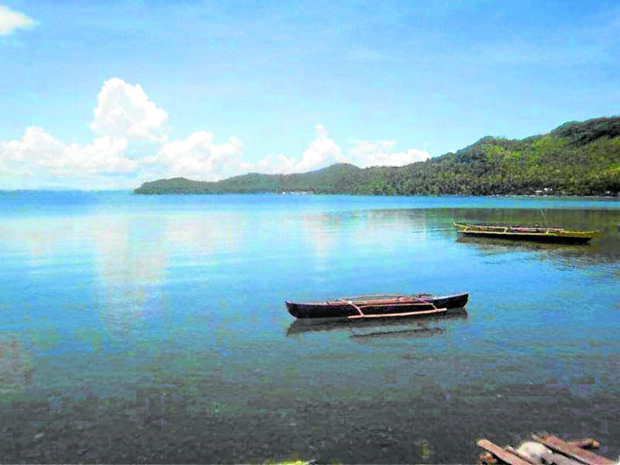3 bays in Samar placed on red tide alert

IDLE | Two fishing boats, in this undated photo, have been left idle by fishermen along the Irong-Irong Bay in Catbalogan City, Samar, which is among the three bays in the provinces of Samar and Eastern Samar where harvesting of shellfish has been banned as these are found to have been contaminated by the red tide toxin. (Photo courtesy of the Philippine Information Agency in Eastern Visayas)
TACLOBAN CITY, Leyte, Philippines — The Bureau of Fisheries and Aquatic Resources (BFAR) has warned the public not to consume shellfish products taken from three bays on Samar Island where the red tide toxin was detected.
“To safeguard human lives, we are issuing this warning as a precautionary advice to the public to refrain from gathering, selling, and eating all types of shellfish and Acetes sp. locally known as ‘alamang’ or ‘hipon’ from these bays,” said BFAR in its local shellfish bulletin on Friday.
According to BFAR, affected by the red tide toxin were the Irong-Irong Bay in Catbalogan City, Samar province; the coastal waters of Calbayog City, also in Samar; and Matarinao Bay in Eastern Samar province.
The bloom of this toxic organism returned in Matarinao Bay after three weeks of red tide absence and in Irong-Irong Bay after nine months, the agency said. The coastal waters of Calbayog City were included in the red tide watch in early 2022.
Matarinao Bay covers the coastal waters of the Eastern Samar towns of General MacArthur, Hernani, Quinapondan, and Salcedo.
Article continues after this advertisementBFAR said the change in weather patterns caused the red tide blooms in the Eastern Visayas region.
Article continues after this advertisementSafe to eat
Fish, squid, crab, and shrimp gathered from these areas are safe to eat provided that all entrails are removed and the marine products are washed thoroughly with running water before cooking.
While the shellfish ban has been lifted in some areas in the region, BFAR said monitoring will continue to check possible recurrence.
Water and shellfish meat samples from the three bodies of water will be sent to their main office for confirmatory testing, it said.
The regular water sample checks cover the coastal waters of Daram, Zumarraga, Cambatutay, Maqueda, and Villareal in Samar; coastal waters of Guiuan, Eastern Samar; San Pedro Bay in Samar; coastal waters of the towns of Leyte, Calubian, and Sogod, Ormoc City, Carigara Bay in Carigara and Cancabato Bay in Tacloban City, all in Leyte; and the coastal waters of the island-province of Biliran.
These areas had a history of red tide recurrence in the past years, according to BFAR.
READ: Shellfish ban: Red tide alert up in Samar
READ: Red tide organisms confirmed in more Samar bays; shellfish ban on
READ: 2 dead, 20 ill in red tide poisoning in Samar bay
BFAR regularly analyzes water samples from these areas, through its regional laboratory, to ensure that shellfish gathered here are safe for human consumption.
If seawater turns positive for red tide, the agency gathers and sends meat to their national laboratory for thorough analysis.
Be extra vigilant
Red tide is a term used to describe a phenomenon where the water gets discolored by high algal biomass or the concentration of algae.
BFAR asked local governments to exercise extra vigilance against the gathering, trading and consumption of shellfish to prevent the incidence of paralytic shellfish poisoning (PSP) which can occur minutes after ingesting bivalve shellfish such as mussels, oysters, and clams that contain red tide toxins.
Consuming toxic shellfish could lead to PSP which affects the nervous system within 30 minutes after consumption.
Symptoms of PSP include tingling of the lips and tongue which spreads to the face, neck, fingertips, and toes. It will also lead to headaches, dizziness, and nausea, among others.
In severe cases, BFAR said muscular paralysis and difficulty in breathing may occur within five to 12 hours.
Red tide happens when there is an overgrowth of algae, which causes the color of the water to turn red, green or brown.
Some of these algae produce toxic chemicals, contaminating the shellfish that consume them.
So far, there is no antidote or direct treatment for PSP, but BFAR said symptoms may be treated by inducing vomiting and pumping the stomach.